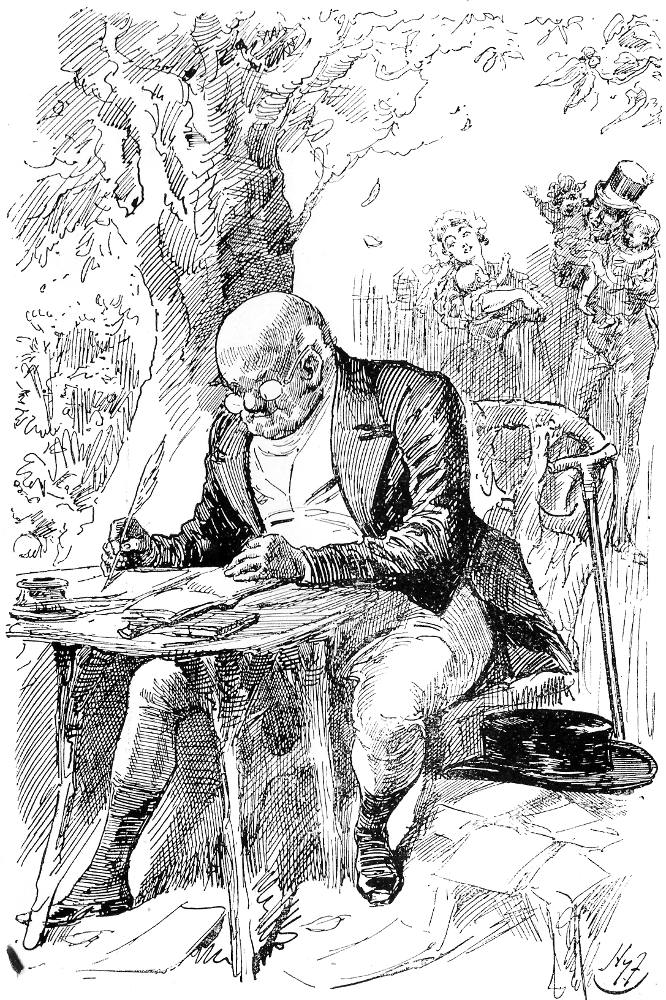

Mr. Pickwick by J. Clayton Clarke ("Kyd") for the 1910 watercolour series: reproduced on John Player cigarette card no. 16: Ninety-two Characters from Dickens: The Pickwick Papers. 2 ½ inches high by 1 ¼ inches wide (6.3 cm high by 3.3 cm wide). [Click on the images to enlarge them.]
"It's always better on these occasions to do what the mob do."
"But suppose that there are two mobs," suggested Mr. Snodgrass.
"Shout with the largest, replied Mr. Pickwick.
There are dark shadows on the earth, but its lights are stronger in the contrast. — A Charles Dickens Day Book ("January"), pp. 4-5.

Of the set of 50 cigarette cards, initially produced in 1910 and reissued in 1923, fully 13 or over 25% concern a single novel, The Pickwick Papers, attesting to the enduring popularity of the picaresque comic novel and also suggesting that the later, darker novels such as Our Mutual Friend and The Mystery of Edwin Drood offered little for the caricaturist, the only late characters in the series being the singularly unpleasant Silas Wegg and Rogue Riderhood from Our Mutual Friend, and Turveydrop, Jo, Bucket, and Chadband from Bleak House.
Commentary: The Evolution of the Iconic Image of Mr. Pickwick (April 1836 to 1910)
If one may judge by Kyd's ninety-two caricatures of Dickens's characters, the popular taste in 1910 was clearly still towards the earlier farce and character comedy of Dickens and the earlier illustrators. We can trace the evolution of the Pickwick image directly from Robert Seymour in Mr. Pickwick Addresses the Club in the earliest serial numbers directly to the genial caricature of Harry Furniss in the second volume of The Charles Dickens Library of 1910:
Left: Title-page vignette for the 1873 Household Edition: Mr. Pickwick in a wheelbarrow (Phiz). Left of centre: From the American Household Edition: Mr. Pickwick" by Thomas Nast Second Frontispiece. [Pickwick under the mistletoe at Dingley Dell]. Right of centre: Harry Furniss's 1910 interpretation: Mr. Pickwick. Right: Sol Eytinge, Jr.'s portrait for the 1867 Diamond Edition: Mr. Pickwick and Sam Weller. [Click on the images to enlarge them.]
Kyd's representations are largely based on the original illustrations by Phiz and Seymour, although the modelling of the figures is suggestive of Phiz's own, expanded series for Household Edition volume of the 1873. The anomaly, of course, is that Kyd should elect to depict minor figures from the first Dickens novel such as the Dingley Dell cricketers Dumkins and Luffey and the minor antagonist Major Bagstock in Dombey and Son, but omit significant characters from such later, still-much-read novels as A Tale of Two Cities and Great Expectations. Five of the fifty or 10% of the series come from the cast of The Adventures of Oliver Twist; or, The Parish Boy's Progress (1837-39): Oliver himself, asking for more; Fagin with his toasting fork, from the scene in which he prepares dinner for his crew of street-boys; Sikes holding a beer-mug, and the Artful Dodger in an oversized adult topcoat and crushed top-hat. Surprisingly, some of the other significant characters, including Nancy and Rose Maylie, are not among the first set of fifty characters, in which Kyd exhibits a strong male bias, as he realizes only seven female characters: only the beloved Nell, the abrasive Sally Brass, and the quirky Marchioness from The Old Curiosity Shop, Sairey Gamp from Martin Chuzzlewit, Aunt Betsey Trotwood from David Copperfield, the burly Mrs. McStinger from Dombey and Son, and the awkward Fanny Squeers from Nicholas Nickleby appear in the essentially comic cavalcade.
Clearly the popular taste in "Characters from Dickens" as well as in "novels from Dickens" has changed a good deal over the past century, so that, even though educated readers would probably associate the name "Pickwick" with Dickens, they might not recognize the balding retired businessman dressed in the fashion of the Regency, and would not understand that he is twenty-four-year-old Charles Dickens's vehicle for satirising amateur "learned" associations of the early 1830s such as the British Society for the Advancement of Science or the BA (founded in 1831).
Scanned images and text by Philip V. Allingham. [You may use these images without prior permission for any scholarly or educational purpose as long as you (1) credit the person who scanned them and (2) link your document to this URL in a web document or cite the Victorian Web in a print one.]
Bibliography
Dickens, Charles. The Posthumous Papers of the Pickwick Club. Illustrated by Robert Seymour, R. W. Buss, and Hablot Knight Browne ('Phiz'). London: Chapman & Hall: April 1836 through November 1837.
_____. Posthumous Papers of the Pickwick Club. Frontispieces by Felix Octavius Carr Darley and Sir John Gilbert. The Household Edition. 55 vols. New York: Sheldon & Co., 1863. 4 vols.
_____. Posthumous Papers of the Pickwick Club. Illustrated by Thomas Nast. The Household Edition. 22 vols. New York: Harper and Brothers, 1873. Vol. 2.
_____. Posthumous Papers of the Pickwick Club. Illustrated by Hablot Knight Browne ('Phiz'). The Household Edition. 22 vols. London: Chapman and Hall, 1874. Vol. 5.
_____. Posthumous Papers of the Pickwick Club. Illustrated by Harry Furniss. The Charles Dickens Library Edition. 18 vols. London: Educational Book, 1910. Vol. 2.
_____. Posthumous Papers of the Pickwick Club. Illustrated by Sol Eytinge, Jr. The Diamond Edition. 14 vols. Boston: Ticknor & Fields, 1867. Vol. 1.
_______. Posthumous Papers of the Pickwick Club. Illustrated by Thomas Nast. The Household Edition. 16 vols. New York: Harper and Brothers, 1873. Vol. 4.
Hill, Elizabeth W., and Martha H. Starr. "Samuel Pickwick." A Dickens Day Book. Washington, DC: Starrhill Press, 1987. 4-5.
Created 6 January 2015;
Last modified 25 June 2025



